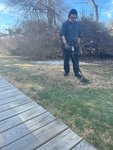
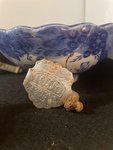
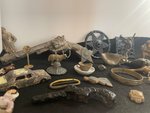
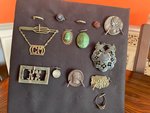
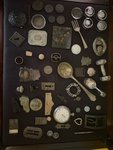
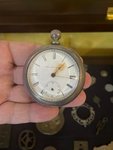
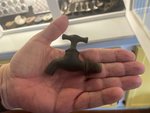
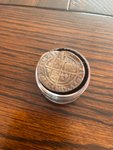
It’s not about the money or the glory one might associate with antique finds.
Rather, for Bellport-based metal detectorist and local historian Mike Pisano, it’s all about the hunt and finding the story behind each and every item he uncovers.
Pisano, 58, is a retired private chef married to city-raised therapist, Erena DiGonis. He has two grown children and after years of renting properties, he and his wife settled down in little old Bellport, on the serendipitously history-rich South Country Road, in 2019.
His home, which was built in 1816, dates back over 200 years as one of the original settlements in Bellport. The home was originally built on land of the homesite of Alexander Munsell, a Tory—someone who was pro-British during the American Revolution—from Smithtown. After the Revolutionary War, Munsell decided that it might be best to relocate to Bellport (then known as Starrs’s Neck) for a fresh start and a new beginning. Munsell (who died in 1807) left a large portion of his land to his eldest son John, who in turn built the small house along South Country Road as a wedding gift for his son Henry and his new wife Phoebe, to operate as a tavern. Since then, about half a dozen owners have lived in it—all of which Pisano has dug up and learned about through his metal detecting finds.
“Every person who has been here has left something,” he said, “and I can attribute almost all of them to individual owners, based on date and who was living here at the time.”
Pisano started metal detecting for fun as a teen and had forgotten about the hobby until later in his life, when a friend of his from Gettysburg said they were finding interesting things with their detectors. His original metal detector was simple and barely detected much.
“You couldn’t find a manhole cover if you were standing on it with that old thing,” he joked.
About 15 years ago, when he got back into it, he decided to buy a much better detector. Since then, Pisano has been sifting through, literally, hundreds of South Shore properties, including Bayport, Sayville, Brookhaven, and especially, Bellport.
He mainly stays to privately owned lands that he has done extensive research on, or wooded areas which had long forgotten settlements. He visits homes—mostly of people he doesn’t know—simply knocks on the door, explains his hobby, and requests access to their yard. Everything he finds belongs to the owner, but if they don’t want it, he happily takes it home to restore.
“When I come knocking, I have already researched your home,” he said, knowing it’s a property he has had his eyes on, lovingly “cyberstalking” the history in excitement for what he might find.
He does all his ventures for free, and would never accept any money. Rather, he said, it’s all about researching the small hometown history of the found items and restoring them to their former beauty.
“People [might] think that I am going to people pocketing stuff, but I’ve never sold anything on eBay,” he said, noting that it really is just a hobby. “I don’t need it, I have my own [stuff]; it’s about the find, and I like to give it to people because I like them to have that piece of their house.”
As for the local small-town history aspect, he said, the local historical societies tend to all note the “rich and famous,” while his finds show the working people and what each home and its residents went through.
“History tends to forget the small things that our ancestors left behind, little details you can’t really get unless you find something you can attribute to them.
“Look at this,” he said, holding up a small weatherworn disc lightly embossed with the word “Magical Cure.” “This was a metal piece that was attached to a corset. They then ran electricity through it and tried to shock away their back pain. They believed that electricity could cure all ills,” he laughed.
His collection includes many other items, including dozens of coins, silver and some gold, but mostly pennies dating back to the 19th century. He has also found and restored plenty of old tavern finds, including cork screws, a wine tap and a keg key, cow bells, and even a sewing machine. His living room shelves are filled with the once lost and now found treasures from his property and another chest filled with some of his favorite finds from local homes, that he was told he could keep.
“I always think, somebody must have lost this and must have gone crazy looking for it,” he said of the items he recovers decades and sometimes centuries later.
His favorite item? An 1812 militia belt buckle found from a Bayport home he was eyeing for months. He also loves an 1867 pocket watch, which still has the original crystal intact; several makeup pieces, such as a lipstick tin ornately engraved with a lovely rose color still inside, though no longer usable of course; jewelry, including a ring with a stone carved from Rome; and teacups and cutlery that hasn’t been inside his home since Abraham Lincoln was president.
Most everything he finds is only 4 to 6 inches underground, sometimes a few more, but after going through all the more modern trash including coins, gum wrappers and nails, he finds the items that date back to the 18th and 19th centuries.
“For every cabinet I have of good finds,” he said, “I could have had 20 more of junk.”
While searching, he has a method; it’s not just mindless metal detecting, but more so something he calls “gridding,” which entails placing a flag and using his machine to carefully sift the property listening to the different noises that pieces make and making note of where the detector chimes. To properly comb a property, he said, could take months, though he usually spends a few days at private homes he has been invited to.
The interesting part of the hobby, he said, is that it leads to all sorts of side interests, including learning how to restore the items and how to research what they are in local newspaper archives, including the former Patchogue Advance and other online databases.
“I know more about 18th-century buttons than anyone should know,” he said laughing. “It’s history, small history, that you can’t ever get back, and something that most people would just walk past.”
Comments
No comments on this item Please log in to comment by clicking here